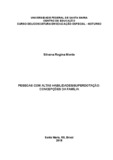| dc.contributor.advisor | Negrini, Tatiane | |
| dc.creator | Monte, Silvana Regina | |
| dc.date.accessioned | 2019-02-01T13:14:01Z | |
| dc.date.available | 2019-02-01T13:14:01Z | |
| dc.date.issued | 2018-12-11 | |
| dc.date.submitted | 2018 | |
| dc.identifier.uri | http://repositorio.ufsm.br/handle/1/15519 | |
| dc.description | TCC de Graduação. | por |
| dc.description.abstract | The present research results from the Conclusion Work of the Special Night Education Course linked to
the Education Center of the Federal University of Santa Maria. It is known that there are many myths
about High Skills / Giftedness, and often the family is unaware of the characteristics and rights that these
subjects have. So there was a need to know what the family previously thought about giftedness and
what they think after their child is identified. The general objective was to investigate how the family
visualizes the high abilities / giftedness in the child and the effects resulting from this conception in his
school and social daily life. Some theoreticians were used as basements, such as Aspesi (2007);
Dessen (2007); Freitas; Pérez (2012); Gardner (2001); Perez (2003), (2009), (2011); Renzulli (1986),
(2014); Virgolim (2014); Winner (1998); among others to support this work. The research is qualitative,
of the study case type. The instrument of data collection was the semistructured interview, which was
based on a script and was recorded. A family that has a child identified with High Abilities / Giftedness
was invited to participate in this research in Santa Maria, State of Rio Grande do Sul. Therefore, the
analysis of the research was organized into three categories: Knowledge about High Abilities /
Giftedness; Student identification process; Student development in school. The participant family is
characterized by the type of separated parents, where the mother reports that only she participates in
the cognitive, social and affective development of the child recently identified with High Abilities /
Giftedness, and in her speech the mother reports how the child was identified, what she knew about this
subject before and how the child's development at school was and is being. In this context it can be
seen that it is important to research and bring to the knowledge of other professionals this theme of High
Abilities / Giftedness, in order to deconstruct erroneous concepts that involve this theme. | eng |
| dc.language | por | por |
| dc.publisher | Universidade Federal de Santa Maria | por |
| dc.rights | Acesso Aberto | por |
| dc.rights.uri | http://creativecommons.org/licenses/by-nc-nd/4.0/ | * |
| dc.subject | Educação especial | por |
| dc.subject | Família | por |
| dc.subject | Altas habilidades/superdotação | por |
| dc.subject | Concepções | por |
| dc.subject | Special education | eng |
| dc.subject | Family | eng |
| dc.subject | High abilities/giftedness | eng |
| dc.subject | Conceptions | eng |
| dc.title | Pessoas com altas habilidades/superdotação: concepções da família | por |
| dc.title.alternative | People with high abilities/ giftedness: family conceptions | eng |
| dc.type | Trabalho de Conclusão de Curso de Graduação | por |
| dc.degree.local | Santa Maria, RS, Brasil | por |
| dc.degree.graduation | Curso de Licenciatura em Educação Especial Noturno. | por |
| dc.description.resumo | A presente pesquisa é resultante do Trabalho de Conclusão do Curso em Educação Especial Noturno
vinculado ao Centro de Educação, da Universidade Federal de Santa Maria. Sabe-se que existem
muitos mitos em relação às Altas Habilidades/Superdotação, e que, muitas vezes a família desconhece
as características e os direitos que esses sujeitos têm, por isso buscou-se saber o que a família pensava
antes sobre superdotação e o que pensa depois de seu filho ser identificado. O objetivo geral foi
investigar de que forma a família visualiza as altas habilidades/superdotação no filho e os efeitos
decorrentes dessa concepção no cotidiano escolar e social do mesmo. Utilizou-se como embasamento
alguns teóricos, como Aspesi (2007); Dessen (2007); Freitas; Pérez (2012); Gardner (2001); Perez
(2003), (2009), (2011); Renzulli (1986), (2014); Virgolim (2014); Winner ( 1998); entre outros para
respaldar esse trabalho. A pesquisa é qualitativa, do tipo estudo de caso. O instrumento de coleta de
dados foi a entrevista semiestruturada, que teve como base um roteiro e foi gravada. Para participar
desta pesquisa foi convidada uma família que tem um filho identificado com Altas
Habilidades/Superdotação, em Santa Maria, no Estado do Rio Grande do Sul. Diante disso, a análise
da pesquisa foi organizada em três categorias: Conhecimento sobre Altas Habilidades/Superdotação;
Processo de identificação do aluno; Desenvolvimento do aluno na escola. A família participante se
caracteriza do tipo de pais separados, onde a mãe relata que apenas ela participa do desenvolvimento
cognitivo, social e afetivo do filho identificado recentemente com Altas Habilidades/Superdotação,e em
sua fala a mãe relata como foi a identificação do filho,o que ela conhecia antes sobre esse tema e como
foi e está sendo o desenvolvimento do filho na escola. Neste contexto pode-se perceber que é
importante pesquisar e levar ao conhecimento de outros profissionai s esse tema de Altas
Habilidades/Superdotação, afim de desconstruir conceitos errôneos que envolvem esse tema. | por |
| dc.publisher.country | Brasil | por |
| dc.publisher.initials | UFSM | por |
| dc.subject.cnpq | CNPQ::CIENCIAS HUMANAS::EDUCACAO::TOPICOS ESPECIFICOS DE EDUCACAO::EDUCACAO ESPECIAL | por |
| dc.publisher.unidade | Centro de Educação | por |



